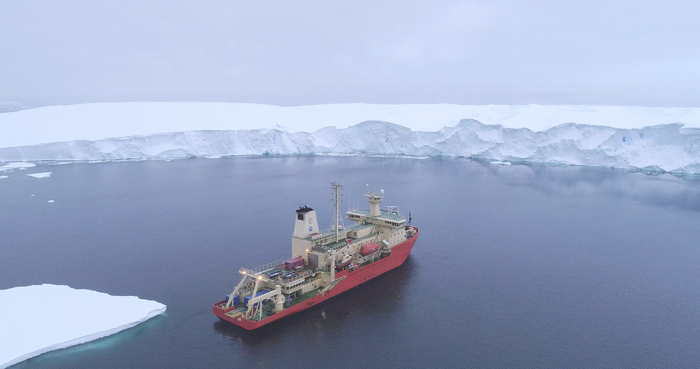For researchers attempting to anticipate the global sea level rise rate, the Thwaites Glacier in West Antarctica, which is about the size of Florida, has been a significant sticking point.
 The R/V Nathaniel B. Palmer was photographed from a drone at Thwaites Glacier ice front in February 2019. Image Credit: Alexandra Mazur/University of Gothenburg
The R/V Nathaniel B. Palmer was photographed from a drone at Thwaites Glacier ice front in February 2019. Image Credit: Alexandra Mazur/University of Gothenburg
When seen in geological periods, this vast ice stream is already in a stage of rapid retreat, known as a “collapse,” which has raised many questions about how much ice it will eventually lose to the ocean and how quickly.
The effects of Thwaites’ retreat might be terrifying: if the glacier and its surrounding glacial basins vanish entirely, the sea level could rise by three to ten feet.
The concern is increased by a recent study published in Nature Geoscience headed by marine geophysicist Alastair Graham of the College of Marine Science at the University of South Florida.
The seafloor in front of the glacier was crucially imaged in high resolution for the first time, providing researchers with a window into how quickly Thwaites advanced and receded in the past.
The breathtaking footage offers a kind of crystal ball to look into Thwaites’ future and reveals geologic aspects that are new to science. Understanding previous behavior is essential to predicting future behavior in humans and ice sheets.
The crew recorded more than 160 parallel ridges left behind when the glacier’s front edge retreated and oscillated with the daily tides.
It’s as if you are looking at a tide gauge on the seafloor. It blows my mind how beautiful the data are.
Alastair Graham, Marine Geophysicist, College of Marine Science, University of South Florida
Graham added that despite its beauty, Thwaites is troubling because the rate of retreat scientists have lately discovered is slow compared to the quickest rates of change in its past.
The scientists examined the rib-like structures 700 m (just under half a mile) beneath the Arctic Ocean to comprehend Thwaites’ previous retreat. They also considered the region’s tidal cycle, as anticipated by computer models, to demonstrate that one rib must have developed each day.
The front of the glacier lost contact with a ridge on the seafloor somewhere in the past 200 years, and for a period of fewer than six months, it retreated at a rate of more than 2.1 km per year (1.3 miles per year), which is twice the rate observed by satellites between 2011 and 2019.
“Our results suggest that pulses of very rapid retreat have occurred at Thwaites Glacier in the last two centuries, and possibly as recently as the mid-20th Century,” Graham said.
“Thwaites is holding on today by its fingernails, and we should expect to see big changes over small timescales in the future–even from one year to the next–once the glacier retreats beyond a shallow ridge in its bed,” said Robert Larter, a marine geophysicist and study co-author of the British Antarctic Survey.
The team, which includes researchers from the United States, the United Kingdom, and Sweden, deployed a cutting-edge orange robotic vehicle dubbed “Rán” from the R/V Nathaniel B. Palmer during an expedition in 2019 to gather the imagery and accompanying geophysical data.
According to Graham, Rán—run by researchers at the University of Gothenburg in Sweden—set off on a 20-hour journey that was both dangerous and fortunate. It did so in harsh conditions during an extraordinary summer remarkable for its absence of sea ice, mapping a region of the seabed in front of the glacier about the size of Houston.
This made it possible for scientists to reach the glacier front for the first time.
“This was a pioneering study of the ocean floor, made possible by recent technological advancements in autonomous ocean mapping and a bold decision by the Wallenberg foundation to invest in this research infrastructure,” said Anna Wåhlin, a physical oceanographer from the University of Gothenburg who deployed Rán at Thwaites.
“The images Ran collected to give us vital insights into the processes happening at the critical junction between the glacier and the ocean today,” Wåhlin said.
It was truly a once-in-a-lifetime mission.
Alastair Graham, Marine Geophysicist, College of Marine Science, University of South Florida
Graham stated that to more precisely date the ridge-like characteristics, the researchers would like to sample the seabed sediments directly.
“But the ice closed in on us pretty quickly and we had to leave before we could do that on this expedition,” he said.
There are still many unanswered concerns, but one thing is certain, according to Graham: The Antarctic ice sheets are not at all what researchers had believed them to be.
“Just a small kick to Thwaites could lead to a big response,” he said.
According to the United Nations, about 40% of people live within 60 miles of the coast.
“This study is part of a cross-disciplinary collective effort to understand the Thwaites Glacier system better, and just because it’s out of sight, we cannot have Thwaites out of mind. This study is an important step forward in providing essential information to inform global planning efforts,” said Tom Frazer, dean of the USF College of Marine Science
The National Science Foundation and the UK Natural Environment Research Council funded the project through the International Thwaites Glacier Collaboration.
Journal Reference:
Graham, A. G. C., et al. (2022) Rapid retreat of Thwaites Glacier in the pre-satellite era. Nature Geoscience. doi.org/10.1038/s41561-022-01019-9.